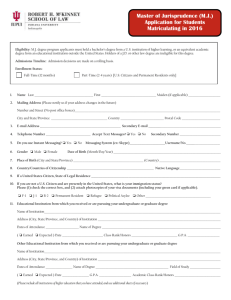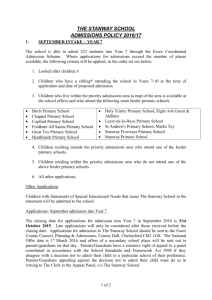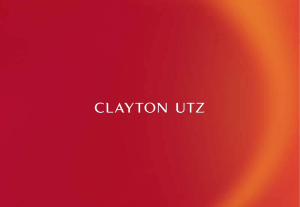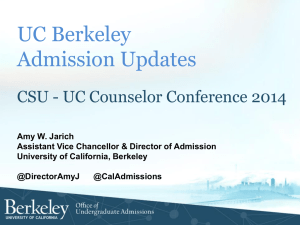Diocesan Admissions Guidance
advertisement
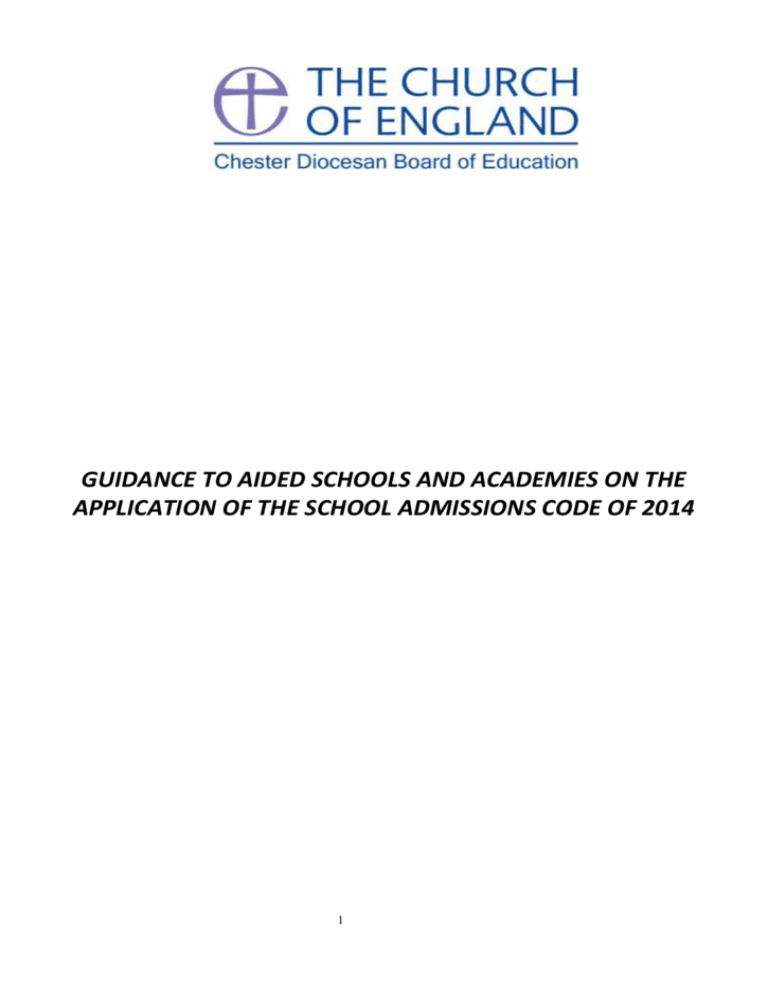
GUIDANCE TO AIDED SCHOOLS AND ACADEMIES ON THE APPLICATION OF THE SCHOOL ADMISSIONS CODE OF 2014 1 Introduction This guidance is based on the admissions code published in December 2014. Changes from the previous code The consultation period has been reduced and moved forward. Consultation must be for a minimum of 6 weeks and must take place between 1 October and 31 January of the school year before those arrangements are to apply. For example: for arrangements which are to apply to applications in 2016 (entry in September 2017), consultation must be completed by 31 January 2016. Admission arrangements must be determined (published) by 28th February (from 2016 for 2017 entries onwards) and sent to local authorities before 15th March. Objections to admission arrangements for entry in September 2016 must be referred to the Adjudicator by 30 June 2015. For all subsequent years, objections must be referred to the Adjudicator by 15 May in the determination year. A change in the wording regarding Looked after Children - The highest priority must be given to looked after children and all previously looked after children. ‘Previously looked after children are children who were looked after, but ceased to be so because they were adopted (or became subject to a child arrangements order or special guardianship order).’ Admission authorities may give priority in their oversubscription criteria to children eligible for the early years’ pupil premium, the pupil premium and also children eligible for the service premium. Admission authorities may give priority in their oversubscription criteria to children eligible for the early years pupil premium, the pupil premium or the service premium who: a) are in a nursery class which is part of the school; or b) attend a nursery that is established and run by the school. The nursery must be named in the admission arrangements and its selection must be transparent and made on reasonable grounds. Admission authorities must make clear in their admission arrangements the process for requesting admission out of the normal age group for example, if the child is gifted and talented or has experienced problems such as ill health. In addition, the parents of a summer born child may choose not to send that child to school until the September following their fifth birthday and may request that they are admitted out of their normal age group – to reception rather than year 1. Continuing requirements of the Code There is a continuing stress on equity and fair access, and on diversity and increased parental choice. Looked after children and previously looked after children must be first in oversubscription criteria Schools MUST NOT give priority to children according to the order of other schools named as preferences by their parents, including ‘first preference first’ arrangements; Children having statements of special educational needs or Education Health and Care plans naming the school must be admitted and counted towards the admission number. A waiting list must be kept until at least the end of the autumn term Admission authorities must ensure that their arrangements will not disadvantage unfairly, either directly or indirectly, a child from a particular social or racial group, or a child with a disability or 2 special educational needs, and that other policies around school uniform or school trips do not discourage parents from applying for a place for their child. Governing Bodies must provide the Local Authority with a list of all children who applied for places, showing each child ranked in order of priority under the admission arrangements, showing which criterion each child met. Governing Bodies can only withdraw the offer of a place in exceptional circumstances, normally a fraudulent or intentionally misleading application, often to do with the address used. The decision to refuse admission must not be made by one individual in a school; the whole Governing Body or its admissions committee should make such decisions. Head Teachers and other school officials should not give parents an expectation that their application will be successful, or tell them their child has been offered a place before the official date. The governing bodies of Aided Schools must consult the Diocesan Board of Education (DBE) about their admissions policies before consulting with other admission authorities. Prohibited criteria The Code prohibits giving higher priority to children according to: Likely parental support for school finances or other practical support given to the school. Parental occupational / financial / educational / social / marital status Parental interests / hobbies A requirement for an expression of practical support for the ethos of the school. Additionally schools may not: discriminate against or disadvantage disabled children or those with special educational needs; Acceptable criteria After the admission of all children with statements of special educational needs or Education Health and Care plans and Looked After Children and previously looked after children who must be the first priority, the governing body needs to work out the order of its criteria from: Special medical or social circumstances affecting the child Where the family lives Whether there will be a sibling in the school at the time of the younger child’s admission. Whether to extend this to include siblings who were previously in attendance at the school (this must be clearly defined). Faith criteria Whether to give priority to the children of staff members and how they might be defined. Distance of home from school. Consultation If there are any changes to the admission arrangements (not including a raise in PAN) or there has been no consultation in the past 7 years, governing bodies must consult on their admission arrangements for a minimum period of 6 weeks between October 1st and January 31st of the school year before those arrangements are to apply. The DBE must be consulted prior to the general consultation. 3 They must consult: Parents of children between the ages of two and eighteen; Other persons in the relevant area who in the opinion of the admission authority have an interest in the proposed admissions; All other admission authorities within the relevant area (except that primary schools need not consult secondary schools); Whichever of the governing body and the local authority who are not the admission authority; Any adjoining neighbouring local authorities where the admission authority is the local authority; The arrangements should include information about: The timetable and how to apply for a place, including the use of supplementary forms The admission number for any year group to which it intends to admit pupils. The oversubscription criteria Where maps of parish boundaries or other defined areas may be viewed, if necessary. How late applications can be made and will be handled For how long a waiting list will be maintained. (It must be for a minimum of the Autumn Term) The definition of home address and evidence The in-year admissions process How parents can appeal if they are refused a place How fraudulent applications are dealt with Deferred or delayed admission to reception and how parents may apply A copy of any supplementary form Faith aspects Voluntary aided schools and some academies (dependent on their funding agreement) may continue to give preference in their admission arrangements to members of their faith or denomination, provided this does not conflict with other legislation, such as equalities legislation or the mandatory provisions of the Code. As with all other maintained schools, church schools must not keep open places if they have insufficient applicants of their own faith and other families have applied for a place at the school. The Code allows the DBE to provide guidance for aided school governing bodies setting out what processes and criteria should be used to establish membership of the faith. The Code also states that where such guidance is produced, the admissions authorities for schools of the faith must have regard to the guidance when framing their admission arrangements. All aided school governing bodies must consult the DBE about the admission arrangements they are proposing for their schools before they go out to statutory consultation with other admission authorities. What the Diocesan Board of Education recommends to all schools; 1) To prioritise all looked after children or previously looked after children; Faith schools must give top priority to such children of their faith group and top priority to those not of the faith group above all other applicants not of the faith. However, we recommend giving top priority to all such children. Such children are deserving of our compassion and should benefit from the Christian care expected in our schools. 4 2) To consider giving a high priority to children with special medical or social circumstances which affect their education or ability to get to school. This criterion is definitely NOT about educational needs. Usually there is a strong argument on physical / geographical grounds for a particular school. The Code indicates that this is an acceptable criterion, but schools must be clear whether it is the child’s needs or the parents’ needs which are considered, citing the example where either parent or child has a disability that might make travel to a school further away more difficult. It could be that both needs are important for primary but only the child’s for secondary. For this category, professional, written evidence must be provided. Schools must also give a clear explanation of how this evidence will be used, and state that it should set out the particular reasons why the school in question is the most suitable school and the difficulties that would be caused if the child had to attend another school. 3) To admit a proportion of local children regardless of faith as appropriate to each school. The Dearing report highlighted the need for the Church schools, in the words of the late Lord Runcie when he was Archbishop of Canterbury, to Nourish those of the faith; Encourage those of other faiths; Challenge those who have no faith. Given this view of the schools as the centres of the Church’s mission, as well as the need for community cohesion, the DBE encourages schools to provide a Christian service to as many local families as appropriate for their situation. 4(a) Where faith commitment is used as a criterion to use regular attendance at worship as the measure of faith commitment. Worship attendance should generally be at public worship on Sundays or other days of the week. It must always be verified by a member of the clergy or a church officer and it is recommended that a signed supplementary information form is used rather than a reference. Forms should not be signed by individuals who are also taking an active part in the ranking of applications. Governors who take part in the admissions process of the school and who have personal contact with applicants as friends or members of their Church should declare an interest. 4(b) To have clear, transparent criteria against which faith commitment will be assessed. The DBE recommends this takes the form of a single hurdle based on regularity of attendance over a set period of time Supplementary form Church schools should use a supplementary form which asks parents about their membership of, or relationship with, the church or religious denomination. Such forms may only ask for additional factual information which has a direct bearing on decisions about oversubscription criteria, e.g. a tick box to confirm attendance and the signature or name of the member of the clergy or a church officer to confirm attendance. Supplementary Forms are not compulsory but governors may point out that failure to complete the form will mean that the governors would not be able to apply the school’s faith criteria. The following information will be obtained from the local authority: Name and address of people with whom child normally lives Siblings who will still be on the school roll at the time of the admission of the younger child. Social/medical/welfare reasons for choice of school (where applicable) Looked after children and previously looked after children Children having a statement of special educational needs or an Education Health and Care Plan. The name of the child and the address of the people with whom they normally live will need may need to be requested on the supplementary information form in order to match up the two forms. The Admissions Committee 5 Where the governing body decides to delegate responsibility for admissions to an admissions committee to consider applications for school places the committee is to be constituted along with other committees at the first meeting of the academic year. It may not include any non-governors, except in the case where the headteacher is not a governor. Decisions as to whether any child should be admitted or not, may not be delegated to the headteacher or any other individual. Example Terms of Reference: The committee is responsible for all matters to do with admissions, subject to the requirement that the full governing body must approve the policy. Decisions as to whether any child may be admitted may not be delegated to the headteacher or any other individual, unless governors are advised that there is a vacancy in the year group. It is advisable not to appoint any governor to the admissions committee if they are involved in the writing of references for applicants under faith criteria. Delegated Powers: 1. To draft the admissions arrangements, including criteria, which must be reviewed and approved annually by the full governing body. 2. To ensure that consultations with the DBE and then other bodies are carried out when required. 3. If the school is over-subscribed, to apply the admissions criteria to all applicants and provide the local authority with a list of pupils ranked in order of the criteria by the due date. 4. To prepare the case of the governing body ready to go to the Appeals Panel 5. To deal with all non-routine admissions. 6 EXAMPLE ADMISSION ARRANGEMENTS The following wording may be used by schools that are either primary or secondary apart from the sections in colour where blue is for secondary and red is for primary. Sections in italic are options that schools may choose or that may be different dependent on the practices of the school or Local Authority. Name of School Parents should be aware before applying that in this school RE, collective worship and our whole ethos are based on the teachings of the Church of England. Making an application Applications for admission to the school should be made on the common application form enclosed with the Local Authority’s brochure. Applications may also be made electronically. In order for the governors to consider applications under faith criteria it is necessary for parents to also complete the school's supplementary information form for criteria numbers …….. The common application form and supplementary form should be completed and returned by ………... Applications may also be made on-line by using both the common application form and the supplementary information form (available from the LA/school website). It is not normally possible to change the order of your preferences for schools after the closing date. Whether application is made on paper or electronically, the common application form must be completed and the supplementary information form should be completed if the applicant wishes faith criteria to apply. Letters informing parents of whether or not their child has been allocated a place will be sent out by the Local Authority on or near 1st March/16th April. Parents of children not admitted will be informed of the reason, offered an alternative place by the Authority and be made aware of their right to appeal. Admission procedures The number of places available for admission to Year 7/the Reception class will be a maximum of.... This arrangement follows consultation between the governing body, the Diocesan Board of Education, Local Authorities and other admissions authorities in the area. The governing body will not place any restrictions on admissions unless the number of children for whom admission is sought exceeds this number. By law, no infant class may contain more than thirty children. The Governing Body operates a system of equal preferences under which they consider all preferences equally and places are allocated accordingly. All children having a statement of special educational needs or Education Health and Care Plan in which the school is named will be admitted. In the event that there are more applicants than places remaining, the governing body will allocate these places using the following criteria, which are listed in order of priority: List here your oversubscription criteria and notes – definitions must be included in the notes dependent upon the oversubscription criteria. Example 1 1. Looked after children and children who were looked after but ceased to be so because they were adopted (or became subject to a child arrangements order or special guardianship order) 2. Children who have a sibling in school who will still be attending school the following year 3. Children whose parent/s are regular worshippers in the Parish Church(es) of .... 4. Children resident in the parish(es) of ..... A map showing the parish is available from the school and is on the school website. 5. Other children. Example 2 1. Looked after children and children who were looked after but ceased to be so because they were adopted (or became subject to a child arrangements order or special guardianship order) 2. Children with special medical or social circumstances affecting the child where these needs can only be met at this school. 3. Children who have a sibling in school who will still be attending school the following year and whose parents are regular worshippers in the Parish Church(es) of .... 4. Children who have a sibling in school who will still be attending school the following year (or who have attended the school in the 2 years prior to admission). 5. Children whose parent/s are regular worshippers in the Parish Church(es) of .... 6. Children resident in the parish(es) of ..... A map showing the parish is available from the school. 7. Other children. Example 3 1. Looked after children and children who were looked after but ceased to be so because they were adopted (or became subject to a child arrangements order or special guardianship order) 2. Children who have a sibling in school who will still be attending school the following year 3. Children whose parent/s are regular worshippers in a Christian church, that is a member of Churches Together in Britain and Ireland. 4. Other children. Example 4 1. Looked after children and children who were looked after but ceased to be so because they were adopted (or became subject to a child arrangements order or special guardianship order) 2. Children who have a sibling in school who will still be attending school the following year or who have attended the school in the 2 years prior to admission. 3. Children who attend the following partner schools ……………………………. 4. Children whose parent/s are regular worshippers in a Christian church, that is a member of Churches Together in Britain and Ireland. 5. Other children. Example 5 1. Looked after children and children who were looked after but ceased to be so because they were adopted (or became subject to a child arrangements order or special guardianship order) 2. Children who have a sibling in school who will still be attending school the following year 3. Children who live in the parish of ……………………. A map is available from the school and is on the school website. 4. Children of staff who have been employed at the school for more than 2 years at the time of application. 5. Children whose parent/s are regular worshippers in a Christian church, that is a member of Churches Together in Britain and Ireland. 6. Other children. Example 6 (A) Foundation Places The governors have designated … places, to be offered to pupils who are themselves or whose parent/s are regular worshippers at …….. (or another Anglican church/Christian church, that is a member of Churches Together in Britain and Ireland). If there are more than …. qualified applicants, places will be allocated according to the following criteria. These are stated in order of priority: i. Looked after children and children who were looked after but ceased to be so because they were adopted (or became subject to a child arrangements order or special guardianship order) ii. Children with special medical or social circumstances affecting the child where these needs can only be met at this school; iii. the presence of a sibling in the school who will still be attending school the following year (or who has attended the school in the two years prior to admission); iv. the nearness of the home to the school measured using an Ordnance Survey address-point system which measures straight line distances in miles from the address point of the school to the address point of the place of residence. In the event of a tie break, a random paper draw will be undertaken by an independent body. It may happen that there are not enough places to admit all applicants meeting any one criterion. In this case the governors will apply the subsequent criteria, in order of priority, to all these applicants. If there are fewer than …. qualified applicants for foundation places, any unfilled places will become additional open places. Unsuccessful applicants for foundation places will be ranked in relevant order within the open place criteria. (B) Open Places The governors have designated …. places each year as open places, to be offered to pupils who do not qualify for a foundation place but whose parents have chosen the school for the type of education it provides. Parents applying for an open place do so knowing that the ethos and collective worship of the school are based on the teachings of the Church of England. If there are more than … applicants, places will be allocated according to the following criteria. These are stated in order of priority: i. Looked after children and children who were looked after but ceased to be so because they were adopted (or became subject to a child arrangements order or special guardianship order) ii. Children with or special medical or social circumstances affecting the child where these needs can only be met at this school; iii. the presence of a sibling in the school who will still be attending school the following year (or who has attended the school in the two years prior to admission); iv. the nearness of the home to the school measured using an Ordnance Survey address-point system which measures straight line distances in miles from the address point of the school to the address point of the place of residence. In the event of a tie break, a random paper draw will be undertaken by an independent body. Example 7 1. Looked after children and children who were looked after but ceased to be so because they were adopted (or became subject to a child arrangements order or special guardianship order) 2. Children who have a sibling in school who will still be attending school the following year 3. Children who are eligible for pupil premium or service premium 4. Children whose parent/s are regular worshippers in the Parish Church(es) of .... 5. Children resident in the parish(es) of ..... A map showing the parish is available from the school and is on the school website. 6. Other children. It may happen that there are not enough places to admit all pupils meeting any one criterion. In this case the governors will apply the subsequent criteria, in order of priority, to all these pupils. Definitions and notes Which notes are to be included will be dependent upon your criteria a) A looked after child is a child who is a) in the care of the Local Authority, or b) being provided with accommodation by a Local Authority in the exercise of their social services functions (under section b) c) d) e) f) g) h) i) j) k) 22(1) of the Children Act 1989) A previously looked after child is one who immediately moved on from that status after becoming subject to an adoption, residence, child arrangements or special guardianship order. Professional supporting evidence from eg a doctor, psychologist, social worker, is essential if admission is to be made under the criterion for special medical or social circumstances, and such evidence must set out the particular reasons why the school is question is the most suitable school and the difficulties which would be caused if the child had to attend another school. Children eligible for the Pupil Premium are those who: are registered as eligible for free school meals; or have been registered as eligible for free school meals at any point in the last six years; Children eligible for service premium are those who have parent(s) who are serving in the regular UK armed forces or who were serving in the past 3 years; or are in receipt of a pension under the Armed Forces Compensation Scheme and the War Pensions Scheme because their parent(s) died on active service with the UK armed forces. By “regular worshipper” we mean ……………….. (eg attendance at a minimum of two services per month for at least one year prior to the closing date for applications). A parent is any person who has parental responsibility or care of the child. Where admission arrangements refer to ‘parent’s attendance at church’ it is sufficient for just one parent to attend. Sibling is defined as children who live as brother or sister in the same house, including natural brothers or sisters, adopted siblings, stepbrothers or sisters and foster brothers or sisters. Staff – includes ……………………. A map showing the boundaries is available from the school and also on the school website. Where the above criteria are not adequate to distinguish between requests for admission which cannot all be accepted without exceeding the admission limit, priority will be decided on the basis of the distance from the school measured by the shortest walking route from the front door of the child’s home address or the main entrance of the block of flats they reside in to the nearest entrance of the school, using the Local Authority’s computerised measuring system, with those living closer to the school receiving the higher priority. In the event of a tie break, random allocation will be used. This process will be independently verified. Waiting list Where we have more applications than places, the admissions criteria will be used. Children who are not admitted will have their name placed on a waiting list. The names on this waiting list will be in the order resulting from the application of the admissions criteria. Since the date of application cannot be a criterion for the order of names on the waiting list, late applicants for the school will be slotted into the order according to the extent to which they meet the criteria. Thus it is possible that a child who moves into the area later to have a higher priority than one who has been on the waiting list for some time. If a place becomes available within the admission number, the child whose name is at the top of the list will be offered a place. This is not dependent on whether an appeal has been submitted. This waiting list will operate until the end of the autumn term. Late applications for admission Where the Local Authority accepts that there are extenuating circumstances for an application being received after the last date for applications, and it is before the governors have established their list of pupils to be admitted, then it will be considered alongside all the others. Otherwise, applications which are received after the last date will be considered after all the others, and where applicable, placed on the waiting list in order according to the criteria. Address of pupil The address used on the school’s admission form must be the current one at the time of application. If the address changes subsequently, the parents should notify the school. Where the parents live at different addresses, the current-at-the-time-of-application, normal address of the child will be the one used. This will normally be the one where the child wakes up for the majority of Monday to Friday mornings. Parents may be asked to show evidence of the claim that is being made for the address, e.g. utility bills of various sorts showing the child’s address as the one claimed. Where there is dispute about the correct address to use, the governors reserve the right to make enquiries of any relevant third parties, e.g. the child’s GP. For children of UK Service personnel and other Crown Servants returning to the area proof of the posting is all that is required. Non-routine admissions It sometimes happens that a child needs to change school other than at the “normal” time; such admissions are known as non-routine admissions Parents wishing their child to attend this school may arrange to visit the school. Parents should contact the school where they will be asked to complete an application form (and supplementary form) and will be offered a place by the governors if one is available. The Local Authority (LA) will be informed of the offer of a place once it has been accepted. If there is no place available in our school then the admissions committee will inform the applicant in writing, together with the LA and information about how to appeal against the refusal will be provided. Where more than one application is received the oversubscription criteria will be used to rank the applications. Please note that you cannot re-apply for a place at a school within the same school year unless there has been relevant, significant and material change in the family circumstances. Appeals Where the governors are unable to offer a place because the school is over subscribed, parents have the right to appeal to an independent admission appeal panel. Parents should fill in an appeals form and return it to ……………….. by ………. Parents will have the opportunity to submit their case to the panel in writing and also to attend in order to present their case. You will normally receive 14 days’ notice of the place and time of the hearing. Please note that this right of appeal against the governors’ decision does not prevent you from making an appeal in respect of any other school. Fraudulent applications Where the governing body discovers that a child has been awarded a place as the result of an intentionally misleading application from a parent (for example a false claim to residence in the catchment area or of involvement in a place of worship) which effectively denies a place to a child with a stronger claim, then the governing body is required to withdraw the offer of the place. The application will be considered afresh and a right of appeal offered if a place is refused. Deferred admission Children are eligible for a reception place from the beginning of the school year in which they become 5 years old. However they do not become of compulsory school age until the start of the term after their fifth birthday. After a place has been allocated and accepted parents can request that the school place be deferred until later in the school year and if they do this the place will be held for the child. They cannot however defer entry beyond the beginning of the term after the child’s fifth birthday, nor beyond the school year for which the original application was accepted. Parents can also request that their child attends on a part time basis until the child reaches compulsory school age. Summer Born Children Parents of summer born children (those born between 1st April and 31st August) who wish to delay entry until the following year must speak to the school and Local Authority as soon as possible as this would involve either an in-year application for year 1 or a new application for reception in the following year. An application form should be filled in for the current admission process at the same time as any request to defer entry or ‘back class’ to reception in the following year. The decision will be made taking into account information from the parents and headteacher and should be in the best interests of the child. Parents will be informed of the outcome before primary national offer day. If the request is agreed, the application for the normal age group may be withdrawn before a place is offered. If the request is refused, the parent must decide whether to accept the offer of a place for the normal age group, or to refuse it and make an in year application for admission to year one for the September following the child’s fifth birthday. Parents should be aware that agreement by the school to allow a child to enter reception the following year does not guarantee a place in the class. Parents must apply to the school again the following year and the application will be considered in the normal manner following the oversubscription criteria.

